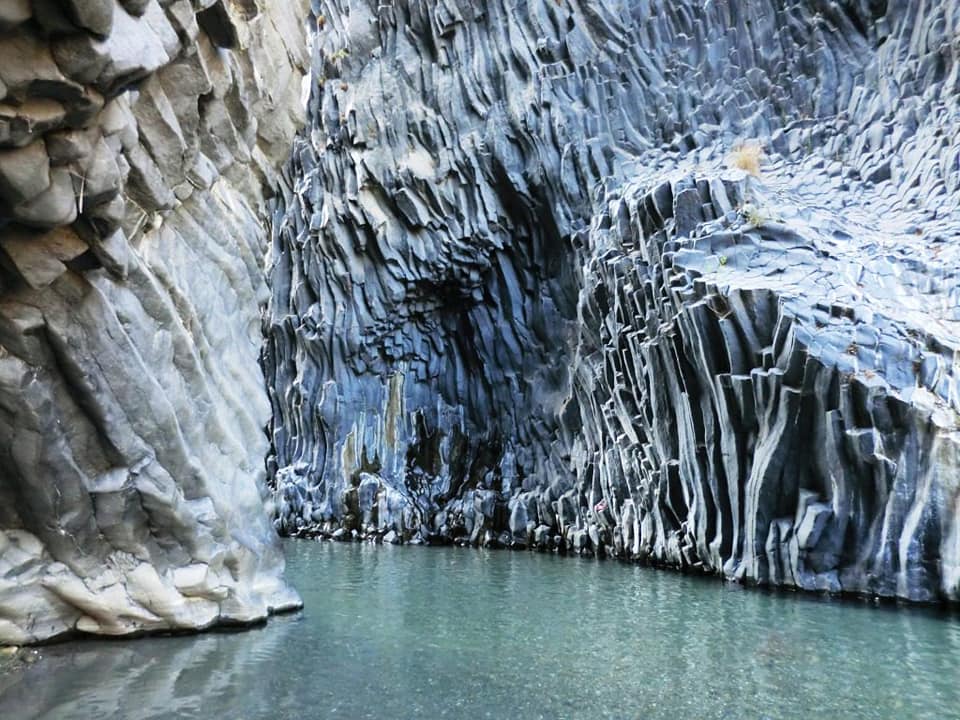
Parco Fluviale dell' Alcantara
Si tratta di uno dei più importanti corsi d'acqua perenne di Sicilia, a cavallo fra le province di Catania e Messina, quasi addossato ai Parchi dell'Etna e dei Nebrodi. Sono circa 40 km di sponde verdeggianti fra castelli e sapori tipici, fra suggestive gole laviche ed endemismi vegetali estremamente interessanti, l'Alcantara si pone come uno dei Parchi più agevoli da visitare, grazie alla statale 185 e una rete viaria di semplice percorso.
"Al Quantarah", il Ponte, in arabo: dal toponimo intuiamo già che fra le sponde di questo fiume scorrono le tracce della Storia. Un viaggio lungo le rive dell'Alcantara, dunque, non sarà solo un viaggio fra la natura e la cultura locale, ma anche dentro la Storia più profonda della Sicilia, quella bizantina, araba e normanna.
Importante e ricco risulta il patrimonio storico, architettonico e culturale della valle.
Dalla foce risalendo sino alla sorgente, sono numerose le località da visitare: partendo da Giardini Naxos, prima colonia greca di Sicilia, è possibile poi raggiungere Taormina, centro di fama internazionale.
Sulla sponda destra del fiume domina la valle il Castello di Calatabiano, di matrice araba.
Continuando la risalita lungo il fiume incontriamo Gaggi, che ha legato il suo nome alle acque che gli scorrono attorno, e Graniti dove è possibile respirare la salubre aria della pineta.Poco più avanti appare Motta Camastra, incastonato nella roccia come un presepe, dal cui belvedere è possibile ammirare la maestosità della valle dell’Alcantara. Proseguendo il nostro cammino ed arrivando a Francavilla di Sicilia, sede amministrativa del Parco, continuiamo il nostro itinerario con una visita al Convento dei Cappuccini.
Per gli amanti delle passeggiate si segnala il sentiero natura "Le gurne dell’Alcantara", dove è possibile inebriarsi dei profumi delle campagne della Sicilia, accompagnati dal continuo scorrere delle acque fresche e limpide dell’Alcantara.
Sul versante opposto troviamo invece Castiglione di Sicilia, sede del Centro di Ricerca ed Educazione Ambientale sugli ecosistemi fluviali. Nel suo territorio si trova la "Cuba" bizantina di Santa Domenica, edificata tra il VII e VIII d.C. e recentemente restaurata. Risalendo ancora il corso del fiume, si raggiungono Mojo Alcantara, Malvagna e Roccella Valdemone, centri agricoli ricchi di testimonianze storiche ed etnoantropologiche A Malvagna è possibile ammirare i resti del Convento dei Minori Riformati di San Giuseppe, risalenti al XVIII secolo. Nei pressi di Mojo è possibile effettuare un’escursione lungo il sentiero che porta all’antico conetto vulcanico eccentrico: i rossastri materiali piroclastici ci fanno immaginare le spettacolari esplosioni che hanno interessato anticamente la zona. Si arriva infine a Randazzo, cittadina sede di tre Parchi - Alcantara, Etna e Nebrodi - nel cui centro storico è possibile visitare la Chiesa di S. Maria, la Chiesa di S. Nicolò e la Chiesa di S. Martino.
(English)
Alcantara Park
It is one of the most important perennial streams in Sicily, straddling the provinces of Catania and Messina, almost leaning against the Etna and Nebrodi Parks. There are about 40 km of green banks between castles and typical flavors, between suggestive lava gorges and extremely interesting plant endemisms, Alcantara is one of the easiest parks to visit, thanks to the state road 185 and a simple road network.
"Al Quantarah", the Bridge, in Arabic: from the toponym we already guess that traces of history flow between the banks of this river. A journey along the banks of the Alcantara, therefore, will not only be a journey through nature and local culture, but also into the deepest history of Sicily, the Byzantine, Arab and Norman one. The historical, architectural and cultural heritage of the valley is important and rich.
From the mouth going up to the source, there are numerous places to visit: starting from Giardini Naxos, the first Greek colony in Sicily, you can then reach Taormina, a center of international fame.
On the right bank of the river the castle of Calatabiano, of Arab origin, dominates the valley.
Continuing the ascent along the river we meet Gaggi, which has linked its name to the waters that flow around it, and Graniti where it is possible to breathe the healthy air of the pine forest. A little further on, Motta Camastra appears, set in the rock like a nativity scene, from whose belvedere it is possible to admire the majesty of the Alcantara valley. Continuing our journey and arriving in Francavilla di Sicilia, the administrative headquarters of the Park, we continue our itinerary with a visit to the Capuchin Convent.
For those who love walking, we recommend the nature trail "Le gurne dell’Alcantara", where it is possible to enjoy the scents of the Sicilian countryside, accompanied by the continuous flow of the fresh and clear waters of Alcantara. On the opposite side we find Castiglione di Sicilia, seat of the Center for Research and Environmental Education on river ecosystems. In its territory there is the Byzantine "Cuba" of Santa Domenica, built between the VII and VIII AD. and recently restored. Going up the river again, you reach Mojo Alcantara, Malvagna and Roccella Valdemone, agricultural centers rich in historical and ethno-anthropological evidence. In Malvagna it is possible to admire the remains of the Convent of the Reformed Minors of San Giuseppe, dating back to the 18th century. Near Mojo it is possible to hike along the path that leads to the ancient eccentric volcanic cone: the reddish pyroclastic materials make us imagine the spectacular explosions that affected the area in ancient times. Finally, we arrive at Randazzo, a town home to three Parks - Alcantara, Etna and Nebrodi - in whose historic center it is possible to visit the Church of S. Maria, the Church of S. Nicolò and the Church of S. Martino.